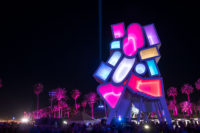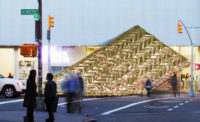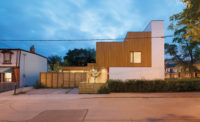Architect Jimenez Lai braved communal desert living at Taliesin West in 2004–05 while studying at the Frank Lloyd Wright School of Architecture in Scottsdale, Arizona. One wouldn't guess that from the projects of Lai's firm, Bureau Spectacular—many of which morph domesticity, outsized furniture, fantasy, and narrative into pavilions and installations—but the experience made a visceral impression.

“At the time, the other students and I saw the poetics of Wright's work, but there were strong techniques deployed and follow-through that I'm trying to emulate,” says Lai, who moved his formerly Chicago-based firm to Los Angeles last fall so that he could teach at UCLA. A current seminar is about movies and storyboarding, a natural topic for Lai, whose graphic novel, Citizens of No Place, published by Princeton University Press in 2012, addressed urbanism and the tradition of paper architects with manga and DC Comics–like drawings.
Lai was born in Taiwan and raised in Toronto, earning his M.Arch from the University of Toronto. After graduating, he lived in a shipping container in Rotterdam while working for the artist Joep Van Lieshout and then in the offices of OMA and REX. He founded Bureau Spectacular in 2008 while teaching at Ohio State University. “For me, it was really important to be in the academy and have a practice,” he says.
For the 2014 Venice Architecture Biennale, Lai designed the Taiwan Pavilion, building nine “houses,” each devoted to a single function such as sleeping or eating. Called Township of Domestic Parts: Made in Taiwan, the houses were colorful and graphic—almost postmodern. He was playing with scale, architectural models, furniture, and the standardization of the domestic program. Lai, who maintains Taiwanese citizenship, flew to Taipei and “presented the project plan with my broken Mandarin” for the chance to design the pavilion. “I wanted to see if there was a way for me to contribute to Taiwan through architecture,” he says. He told his parents, who are not architects, “Consider it to be the Olympics of the sport.”
Currently Lai has an exhibition at the Los Angeles gallery Jai & Jai called Beachside Lonelyhearts (through July 10), where he's covered the walls, ceilings, and floors with white canvas and drawn symbols and shapes referring to a seaside story. Lai calls it a giant “cave painting,” a subject he's interested in because of its relationship to architectural notation. He's also working on an exhibition for L.A.'s Architecture + Design Museum about the city's housing typologies. For the Chicago Architecture Biennial, opening in October, he's developing an installation that will play with the idea of architecture as a stage set—“a backdrop for people to behave a little differently,” he says. “The U.S. has never before had a major architectural biennial,” he continues. “It's kind of amazing and exciting to consider a critical mass forming here.”
Bureau Spectacular is now a band of three, but Lai credits all who have passed through the office (where he often cooks for colleagues). Asked why he named the firm as he did, Lai jokes that he's always liked the acronym (BS). “It was also at a time when I was more immature. I didn't quite have the sense of subtlety that I have now.” He says that the optimism of the full name is still valid: “We're still looking at things in the best light.”










